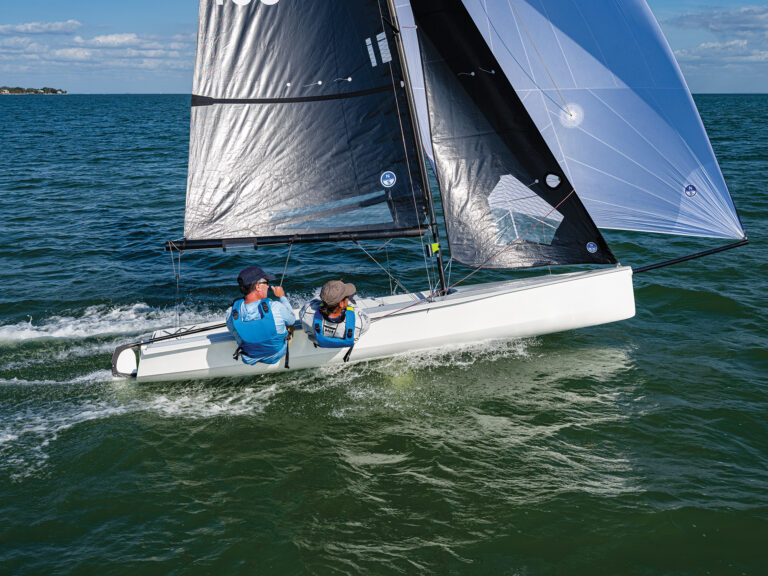
Ray Davies
Emirates Team New Zealand had a near catastrophe on Sunday in their sixth race of the Round Robin series in the Louis Vuitton Cup against Luna Rossa, losing their jib on the first upwind leg when a small clip that fastens the jib to the forestay broke. In a style that has become their own, the Kiwis calmly picked up the pieces – or threw the jib overboard as the case may be – without missing a beat, and stalwartly continued up the course to take the Italians by a hefty 2-minute plus delta. Here, Ray Davies, ETNZ tactician, explains what happened on Sunday’s race, plus he shares some insight into the magic of the foiling jibe…
What happened and how did you recover?
RD: The clip broke, and the jib started coming down. There was no way of rehoisting it because we don’t have a halyard on it. We just have it clipped to the forestay itself at the top of the jib. It’s the first time we’ve had that happen to us. Then, it was a process of deciding what to do. The first idea was just to leave it up because we figured there’d be less drag with it flapping than having it all bunched up on the deck. So we decided, “Let’s just pull it down a little bit but leave it on the forestay.” Then in that process of pulling it down the zipper came undone, and it just blew itself off the forestay.
The obvious decision at that point was to just get rid of it off the boat – we couldn’t contain it at that point. We literally cut it free, it wrapped itself around the side stay, so once we cleared it from there, we just jettisoned it off the boat and were able to get back into normal racing pretty quickly. These boats perform pretty well without a jib. It was a disaster in one sense but we managed to deal with it pretty well and get it off the boat without any further damage to the boat which was key. The loads on the wing increase quite a lot when you don’t have a jib up there, so we had to manage it so that we wouldn’t cause another problem by overloading the wing. So we had to back off somewhat.
What are the clips made of?
RD: It’s a stainless steel clip; it’s a pretty standard sailing item that all yachts use, and I think it’s maintained and serviced. But this one for some reason has failed, and we’re not exactly sure why it failed but there’s a big review going into that at the moment obviously.
How often are the clips replaced?
**RD: **They’re brand new with each sail we put up – you get a couple of months out of each race sail but normally a clip would last … well, in a Volvo race you’d normally get a couple of years out of them, but you do have to keep the maintenance up on them.
Was there any issue with your chase boat picking the abandoned sail off the water in Luna Rossa’s path?
RD: The commentators talked it up quite a lot, but there was no issue really. Luna Rossa saw that our jib was going to be thrown in the water behind us and we’d gone high and slow while we were doing that so LR was starting to fall into our dirty air anyway. They were setting up to tack away before the chase boat moved into the course area. If they weren’t going to hit the chase boat, they would have run over the sail, so it didn’t make any difference if the chase boat was there or not. The sail in the water was a bigger issue for LR – I’d say that’s the main reason why they tacked away so that they didn’t get the sail tangled around their daggerboards.
What did you lose in terms of time/speed without the jib?
**RD: **It’s hard to put a number on it because you do get a little bit limited without a jib – it probably cost us a minute or so around the course.
The Kiwis have nailed the foiling jibe – it looks magical. How long have you had the maneuver in your arsenal of weapons and how do you improve on it?
RD: It’s been on the table since we first started talking about foiling, for a year or so. Even on the team a lot of people thought we wouldn’t be able to foil let alone foil jibe but as it’s all evolved we are able to do these things and that learning curve is still pretty steep. We’re still learning all the time. We started foiling around the bottom mark for example. The better you get at it, the more reliably you’re able to do it with less warning. The next evolution I see [is] doing a few jibes down the run in succession … which suddenly creates options around the course tactically.
What’s the benefit time/distance-wise of a foiling jibe?
RD: The big benefit is keeping the speed up and not having a slow bottom speed. It gets you further down the tracks. You literally can gain or lose 100 meters in a good or bad jibe, so if you can bank that free 100 meters by doing a good jibe, we’ll take it.
Does it blow you away that you’re making foiling jibes on the 72?
RD: Oh, it’s very cool, no question. It’s a lot of fun. A few of us on the team have Moths and it’s the same sort of feeling. It looks amazing, it is amazing, and it continues to be amazing each time you sail it. Whatever foiling boat you’re on, it’s a whole new sensation, and with these boats, it’s a whole other level again. It feels so incredibly efficient and actually pretty easy to do once you get your head around it. It’s just a technique thing, and it’s easier sailing the boat foiling than it is not foiling.
What have you guys been thinking going into these one-boat “races” with your starting strategy?
**RD: **Yeah – we’ve won all our starts so we must be doing something right! Timing and having a good entry is important, where you tack or jibe is very important, and the timing back to the line and where the laylines [are] – even though you’re doing it by yourself the same communication has to happen. You can simulate a start … you’re just not talking about the other boat. It’s a shame that we’re not getting much starting practice in because it’s a very important stage of the race. We’re still learning but not at the same rate we would have if we had a tough competitor there. When we were up against Luna Rossa there was a lot more to talk about and the whole starting sequence changed dramatically from what we were doing by ourselves. We’re desperate for more pre-start practice.
How will this affect ETNZ’s performance against Oracle in the starts if you go through to the AC Finals?
**RD: **For sure that’s an advantage that Oracle has – they’re getting some great boat-on-boat practice and getting used to those close quarters, as well as insight into what each boat was thinking at the time so that they can have some pretty nice debriefs on those sessions. But, there’s only so many moves you can do in two minutes. It’s about being really accurate with where you [are] with laylines and your time on distance. We’re really not too worried.
How do you not show off all your “goods” too soon?
**RD: **I think it comes down to the fact that we’re still learning at the same rate, and if we have a little edge at the moment, potentially we can keep that edge going the whole way. We can’t slow down and stop developing or learning. We still have a few tricks up our sleeves, which we’ll keep up our sleeves until the end. A lot of it is still getting the boat around the track and practicing the maneuvers. If you stop doing the maneuvers you’ll be developing bad habits, so it’s all a process really.
How are you feeling about the conditions in SF?
RD: The racing conditions have been absolutely awesome. We’re going into a phase pretty soon where the racing will start later in the day so we’ll end up statistically in a bit more breeze, but it is just a fantastic venue. The reliability is the main appeal. We don’t have [to do] too much scheduling around the weather because you know it’s going to be good. It’s a great venue for the Cup.
Click here to read more America’s Cup interviews from Michelle Slade.









